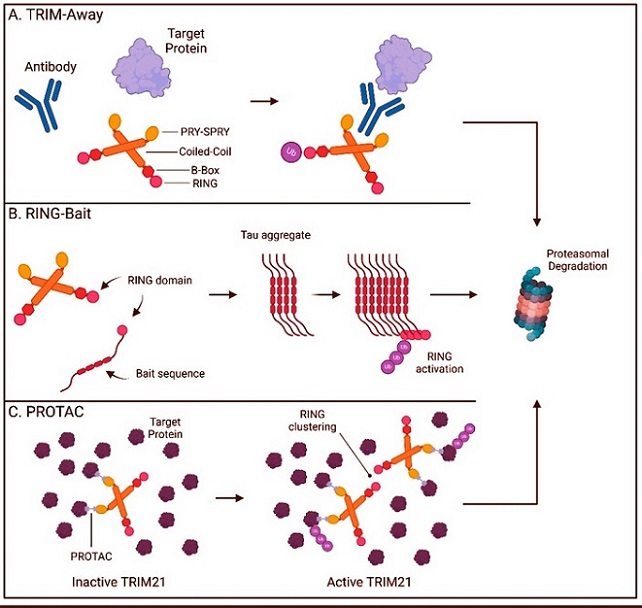Scientists Uncover Powerful Role of TRIM Proteins in Combating Viral Infections and Brain Disorders
Nikhil Prasad Fact checked by:Thailand Medical News Team Apr 17, 2025 1 day, 23 hours, 7 minutes ago
Medical News: A new study from researchers at the Rocky Mountain Laboratories under the National Institute of Allergy and Infectious Diseases (NIAID), part of the U.S. National Institutes of Health (NIH), is creating a wave of excitement in both virology and neuroscience. It shines a spotlight on a special class of proteins called TRIM proteins which seem to possess the unique ability to fight viruses and also prevent or treat a range of central nervous system (CNS) diseases such as Alzheimer’s, Parkinson’s, and Huntington’s.
 TRIM21-based technologies for targeted protein degradation therapeutics. (A) TRIM-Away: TRIM21 binds to the Fc-region of an antibody bound to a target protein promoting the ubiquitination and proteasomal degradation of the antibody and its cargo. (B) RING-Bait: The RING domain of TRIM21 can be fused with a bait molecule consisting of an aggregate-prone tau sequence resulting in its incorporation into the assembling tau fibrils. Clustering of the RING domains promotes the ubiquitination and proteasomal degradation of tau aggregates. (C) TRIM21-based PROTACs promote interactions between TRIM21 and multimeric proteins. Substrate-induced clustering activates the E3 ubiquitin ligase function of TRIM21 to selectively degrade its multimeric targets thereby preventing protein aggregation
TRIM21-based technologies for targeted protein degradation therapeutics. (A) TRIM-Away: TRIM21 binds to the Fc-region of an antibody bound to a target protein promoting the ubiquitination and proteasomal degradation of the antibody and its cargo. (B) RING-Bait: The RING domain of TRIM21 can be fused with a bait molecule consisting of an aggregate-prone tau sequence resulting in its incorporation into the assembling tau fibrils. Clustering of the RING domains promotes the ubiquitination and proteasomal degradation of tau aggregates. (C) TRIM21-based PROTACs promote interactions between TRIM21 and multimeric proteins. Substrate-induced clustering activates the E3 ubiquitin ligase function of TRIM21 to selectively degrade its multimeric targets thereby preventing protein aggregation
This
Medical News report explains how these TRIM proteins, which act like cellular guardians, could become the foundation of future treatments not just for infections like SARS-CoV-2 or Ebola, but also for debilitating brain conditions that currently have no cures.
What Are TRIM Proteins and Why Are They Special
TRIM proteins (Tripartite Motif-containing proteins) are part of a large family of E3 ubiquitin ligases. In simple terms, they help tag unwanted or harmful proteins inside the cell for destruction. This function plays a key role in defending the body against viruses, clearing out toxic protein clumps in brain cells, and maintaining healthy immune responses.
Over 80 types of TRIM proteins exist in the human genome. They act like miniature quality control experts, detecting problematic proteins and directing them toward cellular garbage disposal systems. What's especially fascinating is their double-duty role: on one hand, many TRIMs block viral replication by interfering with the viral life cycle. On the other hand, they also prevent harmful protein buildup in the brain, a hallmark of many neurodegenerative diseases.
TRIM Proteins as Viral Blockers and Sometimes Helpers
The study details how specific TRIM proteins such as TRIM23, TRIM6, TRIM7, and TRIM28 can either fight viruses or—shockingly—be hijacked by the viruses themselves to aid in their replication. For instance, TRIM6 helps block viruses like West Nile virus and influenza by boosting interferon-based immune responses. But Ebola virus can manipulate this same protein to help its own reproduction.
TRIM7 was found to be a double agent as well. It can degrade certain viral proteins to stop replication, yet i
n the case of Zika virus, it helps the virus enter cells more easily. Similarly, TRIM28 promotes antiviral signaling but can also enhance SARS-CoV-2 replication by aiding in the formation of special compartments that protect the virus from immune detection.
A Game Changer in Brain Disease Therapy
Perhaps even more promising is what TRIM proteins can do in the brain. The study reveals that TRIM11 in particular can detect and break apart toxic proteins like tau and alpha-synuclein, which are the culprits behind Alzheimer’s and Parkinson’s disease. In experiments on mouse models of Alzheimer’s, delivering TRIM11 directly to the brain reduced the buildup of these harmful proteins and significantly improved memory and behavior.
In Parkinson’s, TRIM11 showed the ability to prevent the formation of Lewy bodies, which are toxic protein aggregates found in affected brains. Even when these toxic clumps had already formed, TRIM11 could still dissolve them—a rare and powerful trait.
Meanwhile, other TRIM proteins like TRIM19 and TRIM37 also helped clear out mutated proteins involved in Huntington’s disease, offering hope for therapeutic interventions in conditions that were once considered hopeless.
New Drug Strategies That Use TRIM Proteins
The researchers also explored emerging technologies like Trim-Away, PROTACs (proteolysis-targeting chimeras), and RING-Bait, which are designed to exploit TRIM proteins' natural abilities. These tools can be used to design drugs that tell TRIMs to target specific toxic or viral proteins for destruction.
For instance, in experimental models, TRIM21 was used to target harmful tau proteins involved in Alzheimer’s and even viral proteins from SARS-CoV-2. With advances in genetic engineering and nanobodies (tiny antibodies), these TRIM-based therapies could soon become precision tools in treating both infectious and neurodegenerative diseases.
Conclusion
This groundbreaking study presents TRIM proteins as powerful molecular tools that can protect us from both viral invaders and degenerative brain diseases. The ability to customize and enhance their functions through modern biotechnology means we may be entering a new era where previously untreatable conditions could finally be addressed. However, careful research is still needed to ensure these powerful proteins do not accidentally cause harm or trigger excessive immune responses. Their dual function—fighting viruses and maintaining brain health—positions TRIM proteins as one of the most promising targets in modern medical research.
The study findings were published in the peer reviewed journal: Viruses.
https://www.mdpi.com/1999-4915/17/4/562
For the latest on TRIM Proteins, keep on logging to Thailand
Medical News.
Read Also:
https://www.thailandmedical.news/news/japanese-study-finds-that-hmpv-m2-2-protein-inhibits-rig-i-signaling-by-disrupting-trim25-mediated-rig-i-ubiquitination
https://www.thailandmedical.news/news/trim26-and-its-role-in-combating-viral-infections
https://www.thailandmedical.news/news/trim-proteins-can-defend-against-influenza-viruses-and-coronaviruses
https://www.thailandmedical.news/pages/thailand_doctors_listings
https://www.thailandmedical.news/pages/thailand_hospital_listings
https://www.thailandmedical.news/articles/hospital-news
